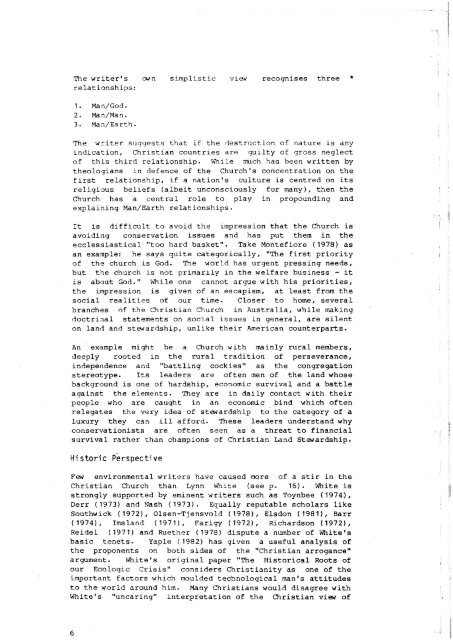soil-conservation-people-religion-and-land.pdf - South West NRM
soil-conservation-people-religion-and-land.pdf - South West NRM
soil-conservation-people-religion-and-land.pdf - South West NRM
You also want an ePaper? Increase the reach of your titles
YUMPU automatically turns print PDFs into web optimized ePapers that Google loves.
The writer's mn simplistic view recognises three *<br />
relationships:<br />
The writer suggests that if the (lestrnction of nature is any<br />
indication, Christian countries are guilty of gross neglect<br />
of this third relationship. While much has been written by<br />
theologians in defence of the Church's concentration on the<br />
first relationship, if a nation's culture is centred on its<br />
religious beliefs (albeit unconsciously for many), then the<br />
Church has a central role to play in propounding <strong>and</strong><br />
explaining ~an/Earth relationships.<br />
It is difficult to avoid the impression that the Church is<br />
avoiding <strong>conservation</strong> issues <strong>and</strong> has put them in the<br />
ecclessiastical "too hard basket". Take Montefiore (1978) as<br />
an example: he says quite categorically, "The first priority<br />
of the church is God. The world has urgent pressing needs,<br />
but the church is not primarily in the welfare business - it<br />
is about God." While one cannot argue with his priorities,<br />
the impression is given of an escapism, at least from the<br />
social realities of our time. Closer to home, several<br />
branches of the Christian Church in Australia, while making<br />
doctrinal statements on social issues in general, are silent<br />
on l<strong>and</strong> <strong>and</strong> stewardship, unlike their American counterparts.<br />
An example might be a Church with mainly rural members,<br />
deeply rooted in the rural tradition of perseverance,<br />
independence <strong>and</strong> "battling cockies" as the congregation<br />
stereotype. Its leaders are often men of the l<strong>and</strong> whose<br />
background is one of hardship, economic survival <strong>and</strong> a battle<br />
against the elements. They are in daily contact with their<br />
<strong>people</strong> who are caught in an economic bind which often<br />
relegates the very idea of stewardship to the category of a<br />
luxury they can ill afford. These leaders underst<strong>and</strong> why<br />
<strong>conservation</strong>ists are often seen as a threat to financial<br />
survival rather than champions of Christian L<strong>and</strong> Stwardship.<br />
Hi storic perspective<br />
Few environmental writers have caused more of a stir in the<br />
Christian Church than Lynn White (see p. 16). White is<br />
strongly supported by eminent writers such as Toynbee (1974),<br />
Derr (1973) <strong>and</strong> Nash (1973). Equally reputable scholars like<br />
<strong>South</strong>wick ( 1972) , Olsen-T jensvold ( 1978) , Elsdon ( 198 1 ) , B arr<br />
(1974), Imsl<strong>and</strong> (1971), Farigy (1972), Richardson (1972),<br />
Reidel (1971) <strong>and</strong> Ruether (1978) dispute a number of White's<br />
basic tenets. Yaple (1982) has given a useful analysis of<br />
the proponents on both sides of the "Christian arrogance''<br />
argument. White's original paper "The Historical Roots of<br />
our Ecologic Crisis" considers Christianity as one of the<br />
important factors which moulded technological man's attitudes<br />
to the world around him. Many Christians would disagree with<br />
White's "uncaringw interpretation of the Christian view of
















